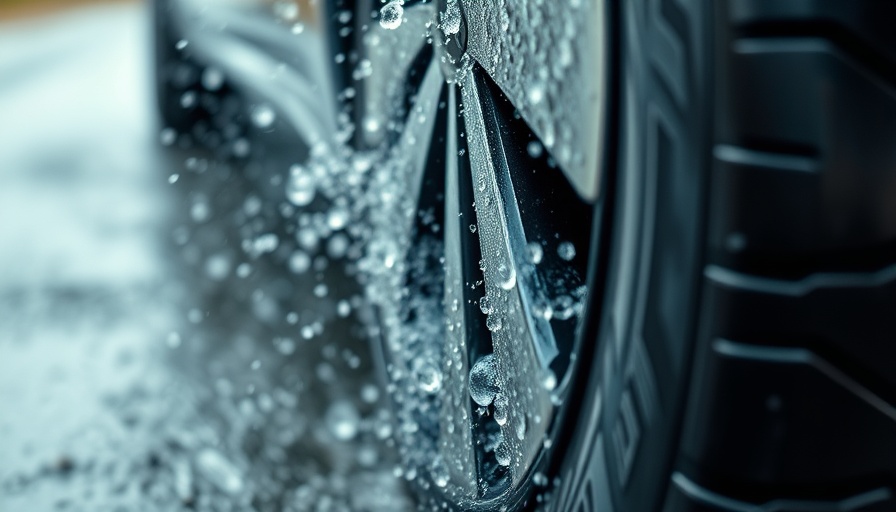
Understanding Hydroplaning: What You Need to Know
Hydroplaning can strike fear into the hearts of drivers, especially when embarking on a long road trip or navigating familiar neighborhood streets during rainy weather. It occurs when a thin layer of water builds up between the road surface and your tires, causing your vehicle to lose traction. This phenomenon can happen under various circumstances, from heavy rain to slick roads after a dry spell. With California's diverse weather patterns, understanding how to prevent and respond to hydroplaning is vital for drivers of all ages.
Why Hydroplaning Causes Loss of Control
The consequences of hydroplaning can be severe. When tires glide over water rather than gripping the road, drivers lose the ability to steer and brake effectively. This loss of control can lead to accidents, especially when drivers attempt to overcorrect by steering sharply. According to defensive driving expert Robert Dillman, maintaining composure is crucial to regaining control. When drivers struggle against the slipperiness of hydroplaning, they may inadvertently make the situation worse.
The Key Factors Contributing to Hydroplaning
Hydroplaning does not have a singular cause; rather, it is a confluence of factors that increase the likelihood of losing traction. Key contributors include:
- Water Accumulation: Roads that are waterlogged present the ideal conditions for hydroplaning, especially if the water depth exceeds the tire tread.
- Road Oil: Oils and fluids can create a slick surface, particularly after a few dry days, which increases the risk of hydroplaning during the first rain.
- Worn or Improperly Inflated Tires: Tires with low tread or incorrect pressure cannot channel water effectively, exacerbating the potential for hydroplaning.
- Poor Road Conditions: Smooth or poorly maintained roads can trap more water, making them more hazardous for drivers, particularly when they’re turning or braking sharply.
Effective Strategies for Avoiding Hydroplaning
Given the dangers associated with hydroplaning, taking preventative measures is essential for all drivers:
- Slow Down: Reducing speed during inclement weather allows tires to better displace water, decreasing hydroplaning risk.
- Maintain Your Tires: Regularly check tire pressure and tread depth to ensure optimal performance during adverse conditions.
- Avoid Sudden Movements: Jerky movements while driving can compound the risk of losing control, particularly on wet roads.
- Recognize Hazardous Conditions: Identify when conditions are favorable for hydroplaning—such as newly wet surfaces or standing water—and adapt your driving accordingly.
Taking Action After Hydroplaning
If you find yourself hydroplaning, the first instinct may be panic. However, following a series of steps can help regain control:
1. **Do Not Slam on the Brakes**: Instead, gently lift your foot off the accelerator to allow the tires to regain contact with the road.
2. **Steer Straight**: Avoid the temptation to jerk the wheel. Keep the steering steady until you feel your tires have connected with the road again.
3. **Remain Calm**: Stay relaxed to better assess the situation and respond effectively. Remaining calm can make a significant difference in navigating through potential hazards.
Adapting to California’s Unique Driving Conditions
Living in California, where the weather can shift dramatically, residents must be aware of how local environmental factors influence driving safety. The diverse climates, from foggy coastal areas to rainy inland regions, each offer their own challenges. Homeowners considering how to protect their property from these weather shifts often overlook the impact of roads on driving safety. Maintaining the landscape, including proper drainage around homes and roadways, can reduce runoff and make a difference in overall safety.
Conclusion: Drive Prepared, Drive Smart
Understanding hydroplaning is vital for drivers, especially in urban and suburban California where rain can be both unpredictable and frequent. By recognizing the causes, implementing safety measures, and knowing how to react if it happens, drivers can protect themselves and others on the road. Each step taken towards driving responsibly contributes not just to personal safety but also to the safety of the entire community.
 Add Row
Add Row  Add
Add 




Write A Comment